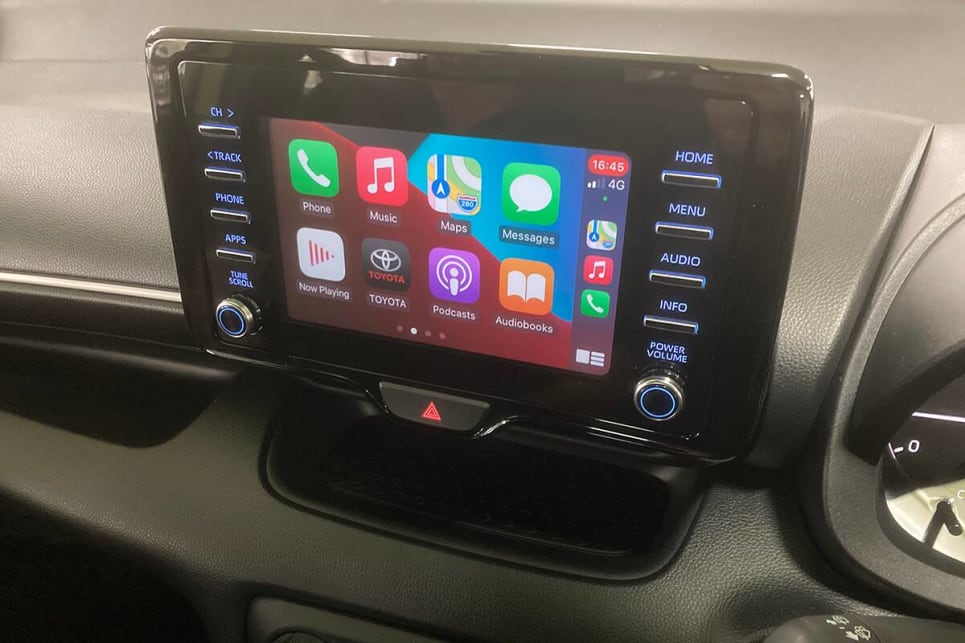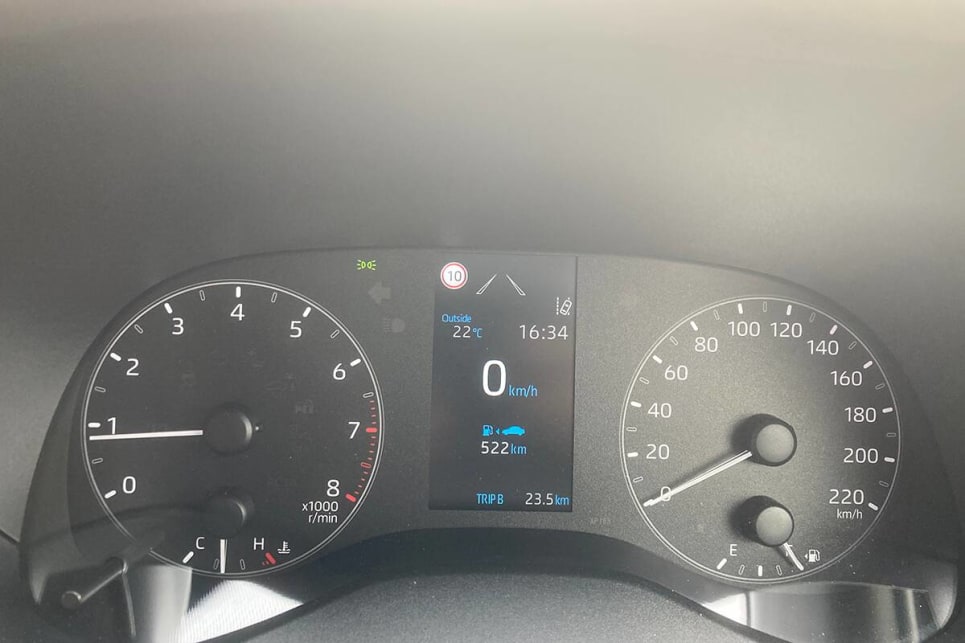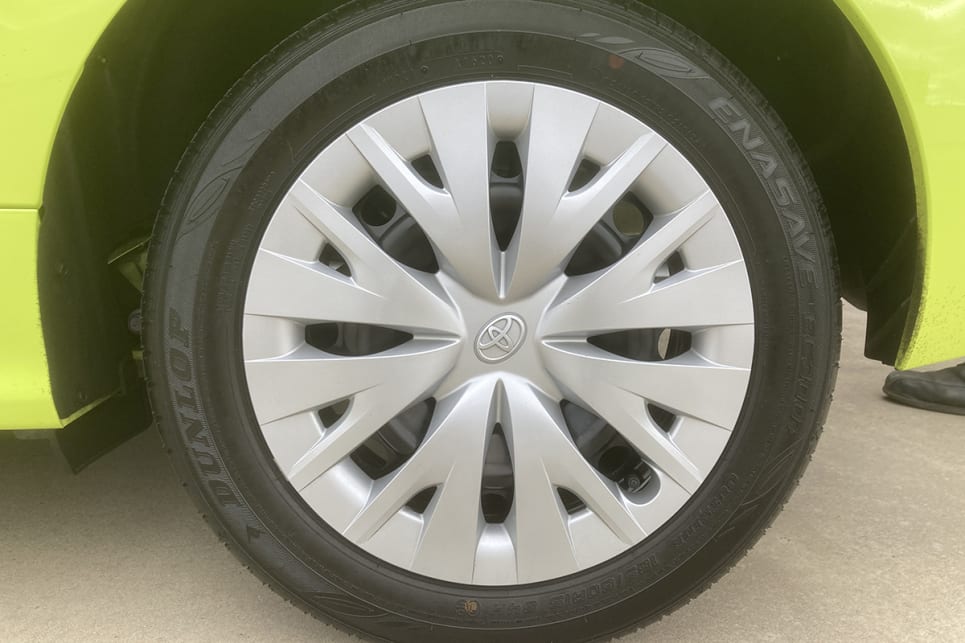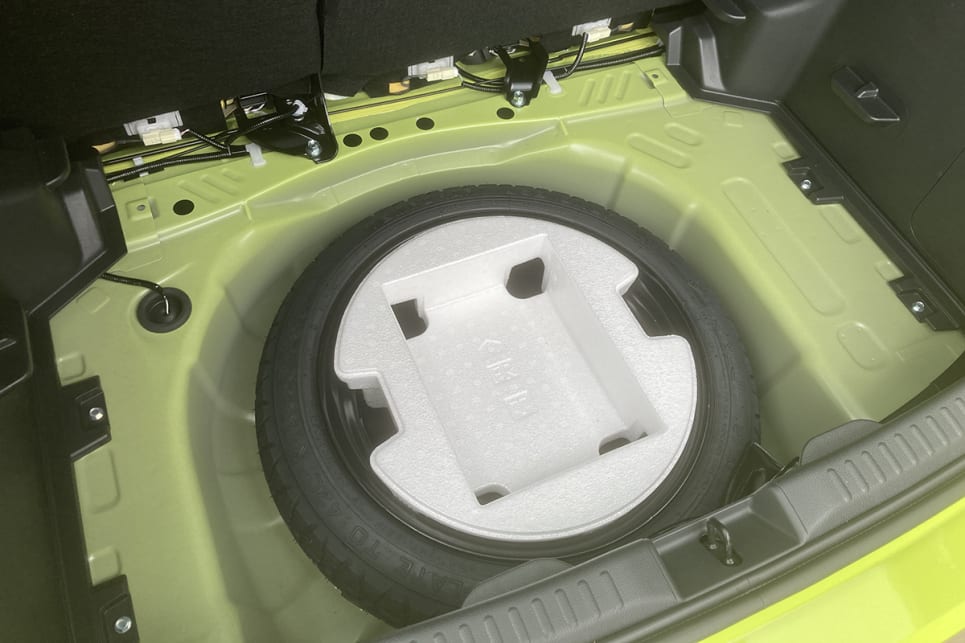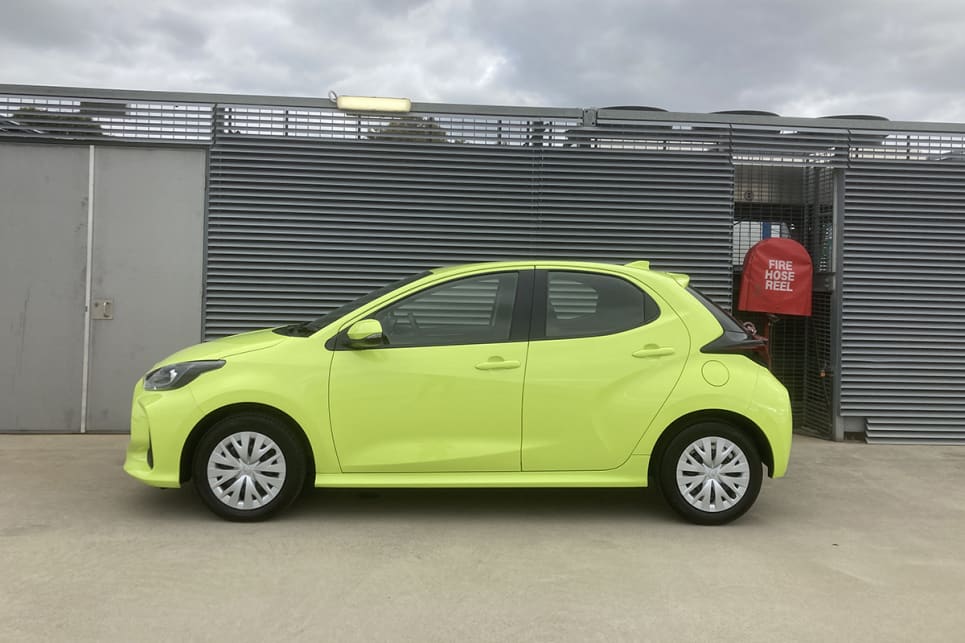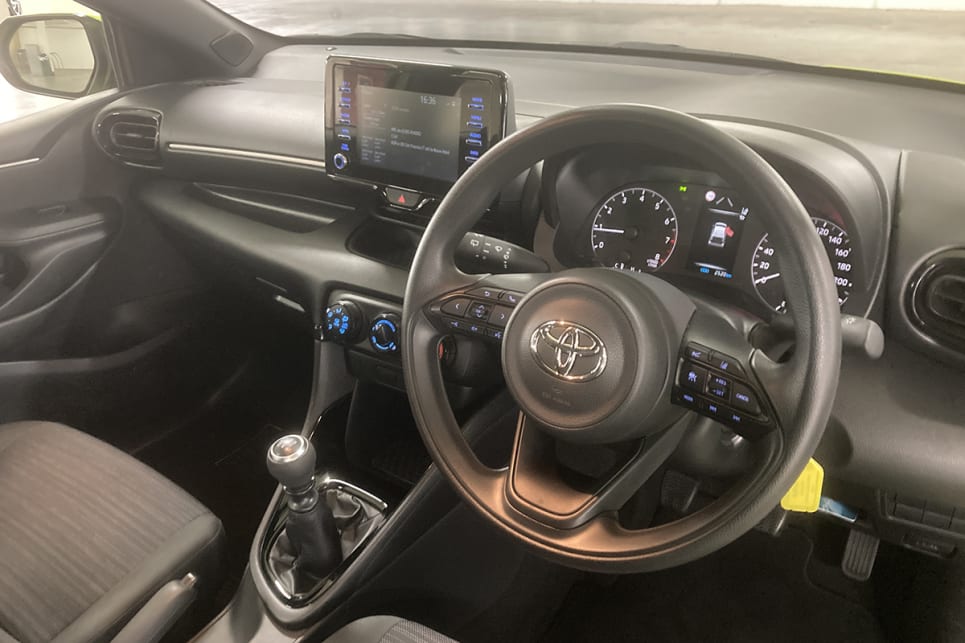
What's on this page
Toyota Yaris 2021
Carsguide Contributing Journalist Byron Mathioudakis had this to say at the time: The Yaris SX Hybrid is not a cheap car at nearly $30K before ORC, but it is a wonderful achievement when you tally up how spacious, refined, spirited, frugal and fun it is. There are enough quality touches and packaging smarts to put this right at the pointy end of the premium supermini class.
You can read the full review here.This is what Byron Mathioudakis liked most about this particular version of the Toyota Yaris: Excellent economy and efficiency, Fun to drive, Attractive interior
Toyota Yaris 2021 Reviews
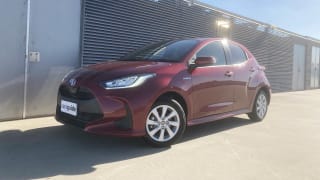
Toyota Yaris Hybrid 2021 review: SX Hatch
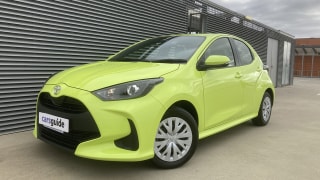
Toyota Yaris 2021 review: Ascent Sport manual
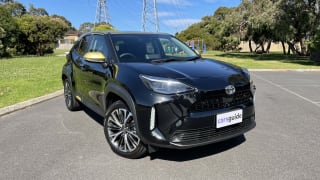
Toyota Yaris Cross 2021 review: Urban 2WD
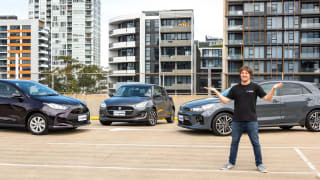
Kia Rio GT-Line, Toyota Yaris SX & Suzuki Swift GLX Turbo - We Compare 3 of the Best Light Vehicles in Australia

Toyota GR Yaris 2021 review
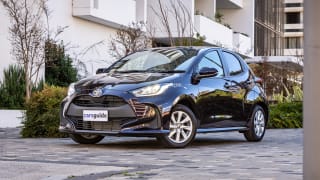
Toyota Yaris 2021 review: SX petrol

Toyota Yaris 2021 review
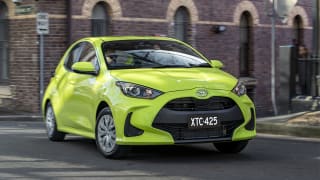
Toyota Yaris Ascent Sport 2021 review: snapshot
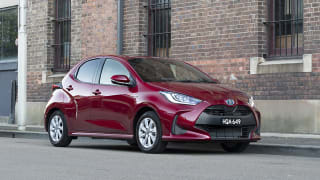
Toyota Yaris SX 2021 review: snapshot
Toyota Yaris 2021 News
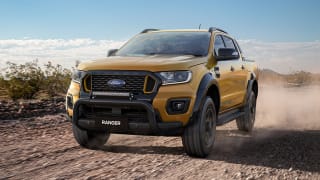
The new cars you can actually buy right now and drive away without waiting - even in a lockdown

Best hatchbacks arriving in 2021

2021 Toyota Yaris GR tuned to a Honda Civic Type R and Volkswagen Golf R-scaring 225kW/385Nm

2021 Toyota Yaris and Yaris Cross Hybrid recalled: New hatchbacks and SUVs could lose power

What is going on with Toyota's pricing? Will the Yaris GR's first-in-best-dressed policy backfire?
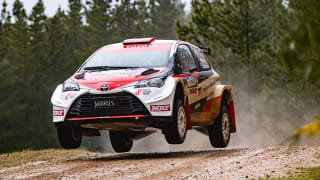
Toyota Yaris GR a special focus for new Gazoo Racing Club to build GR brand as rival to Hyundai's N

2021 Toyota Yaris GR sold out! Special driveaway pricing drove demand for hotter rival to Ford Fiesta ST and Volkswagen Polo GTI

2021 Toyota Yaris GR prices jump up after first batch sells out

New Toyota Yaris GR 2021: Less than half stock remaining at discounted launch pricing
Toyota Yaris 2021 Price and Specs
Pricing guides

| Toyota Yaris Model | Body Type | Specs | Price from | Price to | |
|---|---|---|---|---|---|
| Ascent Sport | Hatchback | 1.5L ULP CVT AUTO | $19,690 | $24,860 | |
| Ascent Sport | Hatchback | 1.5L ULP 6 SP MAN | $18,040 | $22,770 | |
| SX | Hatchback | 1.5L ULP CVT AUTO | $22,550 | $27,830 | |
| SX Hybrid | Hatchback | 1.5L Hyb/ULP CVT AUTO | $24,200 | $29,810 | |
Toyota Yaris 2021 Colours
The Ascent Sport is available in eight colours, from white to Ebony (black), Pearl, Silver Pearl, Atomic Rush (maroon), Scarlet (purple), Lunar Blue (navy), Electric Blue, Cherry Blossom (pink), Coral Rose (red), Bronx Bronze and Electric Green (lime).
- Glacier White
- Ebony
- Crystal Pearl
- Silver Pearl
- Atomic Rush
- Scarlet
- Lunar Blue
- Bronx Bronze
- Cherry Blossom
- Coral Rose
- Electric Blue
- Electric Green
Toyota Yaris 2021 Q&As
Check out real-world situations relating to the Toyota Yaris here, particularly what our experts have to say about them.
-
Would you buy a 2023 Toyota Yaris Hybrid GXL 2WD or a 2018 Toyota RAV4 GXL?
These are quite different vehicles in terms of their physical size. While older generations of the RAV4 were known as compact SUVs, the current model is resolutely mid-sized. None of which is to say that the Yaris is cramped but it is a size-division smaller, so if you often carry people in the back seat or your family is growing, the RAV4 might be a bit more future-proof.
However, in driveline terms, the Yaris is the one that is truly future-proof thanks to its hybrid driveline. If most of your driving is around the city and suburbs, you might be surprised at just how efficient a modern hybrid can be. On the highway, there's less to be gained form the hybrid layout, so take that into account, too.
The other thing to consider is what happens a few years down the track at trade-in time. The RAV4 is question is already one generation older than the Yaris, and the hybrid Yaris is almost certain to be worth more as a second-hand proposition five years from now. Which means the latter will probably be the cheapest to own over that time in a wholistic sense.
Show more -
I intend to leave my 2012 Toyota Yaris in the garage while I am elsewhere in Australia for three months. Is there anything I need to do?
If you were leaving the vehicle standing for a whole year, this would be a bigger problem, but I don’t think three months of inactivity would be too harmful to the car. Plenty of people (particularly Victorians) were forced to lay up their work cars during Covid restrictions, and I haven’t heard of mass problems as a result.
You’re already ahead of some of those folks by having a garage in which to store the car, but there are also a few things you can do to reduce the impact of not moving for three months. Make sure the tyres are inflated to the correct pressure (to avoid flat posts when you return) and fill the fuel tank to reduce the chance of moisture forming in the fuel system. Wind the windows up but leave the bonnet catch undone so you can access the battery when you return.
You can also disconnect the battery but if you do, you’ll have to reprogram or re-code the radio when you return. A better way is to leave the car hooked up to a quality battery trickle-charger. Make sure you use one that is heat and fault-protected.
An even better plan of attack is to organise a trusted friend take the time to drive the car for you every few weeks. Provided they get the car up to operating temperature each time, it should be ready for action when you return.
Show more -
What car should I buy to replace my 2006 Toyota Corolla?
There are still plenty of great small cars around within your budget, Agnes, and they all have good safety packages (or we wouldn’t recommend them). Look at offerings such as the Suzuki Swift Navigator (with the optional autonomous emergency braking) for around $17,000 (plus on-road costs) or the Kia Rio S at around $19,000 or Kia Picanto S (one size smaller than the Rio) at closer to $16,000. Both the Kias also feature the brand’s excellent seven-year warranty, capped-price servicing and free roadside assistance which is great peace of mind.
The Volkswagen Polo is a classy drive but a little more expensive at closer to $21,000 for the 85TSi Comfortline. Actually, to be honest, you’ve missed the boat on bargain small cars by a couple of years. Firm favourites such as the Toyota Yaris and Mazda 2 have both been updated relatively recently and have recorded big price jumps in the process. The cheapest Yaris with an automatic transmission is now around $23,000 (it was less than $17,000 back in 2018) while the Mazda 2 Maxx went from being a sub-$17,000 proposition in 2018 to a $23,000 car by the time you add an automatic transmission in 2020.
Show more -
What cars with high seats and a big boot do you recommend?
If your dad was happy with his previous Yaris, then I think the new model would suit him just as well. Don’t be put off by the lack of a sedan, as the hatchback version is actually even better at swallowing things like wheelchairs. You’d be amazed at just how practical a conventional hatchback is. The real shame is that Toyota no longer sells the three-door version of the Yaris (they’re all five-doors now). Because the three-door model had longer doors, they made getting and in and out even easier. The only catch was that they opened pretty wide (which is why disabled car-parking spaces are extra wide as well).
Show more
Toyota Yaris 2021 Fuel consumption
Fuel consumption for the 2021 Toyota Yaris is dependent on the type of engine, transmission, or model chosen. The Toyota Yaris currently offers fuel consumption from 3.3 to 5.4L/100km. The Toyota Yaris is available with the following fuel types: ULP and Hyb/ULP.
| Toyota Yaris Model | Body Type | Specs | Fuel Consumption | |
|---|---|---|---|---|
| Ascent Sport | Hatchback | 1.5L,ULP,CVT AUTO | 4.9L/100km | |
| Ascent Sport | Hatchback | 1.5L,ULP,6 SP MAN | 5.4L/100km | |
| SX Hybrid | Hatchback | 1.5L,Hyb/ULP,CVT AUTO | 3.3L/100km | |
| ZR Hybrid | Hatchback | 1.5L,Hyb/ULP,CVT AUTO | 3.3L/100km | |
Toyota Yaris 2021 Wheel size
Wheel size for the 2021 Toyota Yaris will vary depending on model chosen, although keep in mind that many manufacturers offer alternate wheel sizes as options on many models.The wheel size available will alter the range of tyres available to be fitted.
| Toyota Yaris Model | Body Type | Front Tyre Size | Front Rim | Rear Tyre Size | Rear Rim | |
|---|---|---|---|---|---|---|
| Ascent Sport | Hatchback | 185x60 R15 8 | — | 185x60 R15 8 | — | |
| SX | Hatchback | 185x60 R15 8 | — | 185x60 R15 8 | — | |
| SX Hybrid | Hatchback | 185x60 R15 8 | — | 185x60 R15 8 | — | |
| ZR | Hatchback | 185x55 R16 8 | — | 185x55 R16 8 | — | |
Toyota Yaris 2021 Dimensions
Dimensions for the 2021 Toyota Yaris are dependent on which body type is chosen. The maximum width and height is 1695mm x 1505mm and can vary on the basis of model.

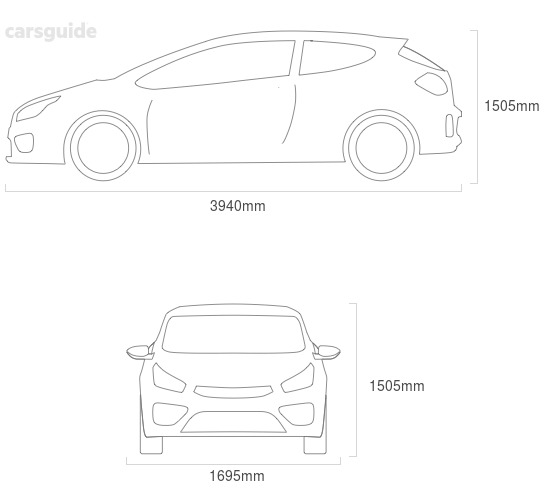
| Toyota Yaris Model | Body Type | Height x Width x Length | Ground Clearance | |
|---|---|---|---|---|
| Ascent Sport | Hatchback | 1505x1695x3940 mm | 150 mm | |
| SX | Hatchback | 1505x1695x3940 mm | 150 mm | |
| SX Hybrid | Hatchback | 1505x1695x3940 mm | 150 mm | |
| ZR | Hatchback | 1505x1695x3940 mm | 150 mm | |
Toyota Yaris 2021 Accessories
The Yaris boasts eight airbags, including centre airbags to help stop the front-seat occupants from crushing each other in lateral collisions. Then there's AEB with pedestrian (day/night) and cyclist (day) detection, daytime intersection assistance, emergency steering assist, adaptive cruise control (but not full stop/go in the manual versions), lane-keep assist, speed-sign recognition, auto high beam, anti-lock brakes with brake assist, traction control, stability control, active cornering assist, secondary collision braking, reverse camera and rear outboard-seating ISOFIX child restraint anchors.
A 7.0-inch touchscreen, digital radio, Bluetooth connectivity and Apple CarPlay/Android Auto compatibility are also included, along with six-speaker audio, voice-recognition technology, trip computer, single-zone air-con, power windows, tilt/telescopic steering wheel adjustment, auto-retractable mirrors, a dual-level cargo floor, 15-inch steel wheels and a temporary spare. Adding premium paint costs $500 and two-tone paint is $450.
Toyota Yaris 2021 Interior
Larger and taller than you might expect a supermini to be, it’s an easy-access, spacious and obviously very well-screwed together cabin that doesn’t feel cheap.
The twin-canister digital instrument layout of the SX and ZR are sidestepped for an elegant analogue binnacle, while there's similarly smart upholstery patterns, tons of storage (including massive front door pockets) and excellent ventilation that easily reaches the rear seat area. And we’re very glad to see a regular manual handbrake too.
Plus, the back row is comfier and roomier than we remember in any previous Toyota supermini, highlighting just how space-efficient this generation is. Thanks, big wheelbase stretch! Feet can be tucked un under the front seats. Shoulder room is fine for two adults, there’s ample head space and your knees aren’t forced into an unnatural and uncomfortable high-up position, that leads to achy buttock syndrome.
Further back, the cargo area is defined by its large tailgate opening and deep, flat load area, with a fake floor to hid stuff under. Clever. A space saver spare is located underneath. Of course, the Ascent Sport features a 60/40 split-fold rear seat, extending the standard cargo capacity of 270L (VDA).
Toyota Yaris 2021 Boot Space
A space saver spare is located underneath. Of course, the Ascent Sport features a 60/40 split-fold rear seat, extending the standard cargo capacity of 270L (VDA).
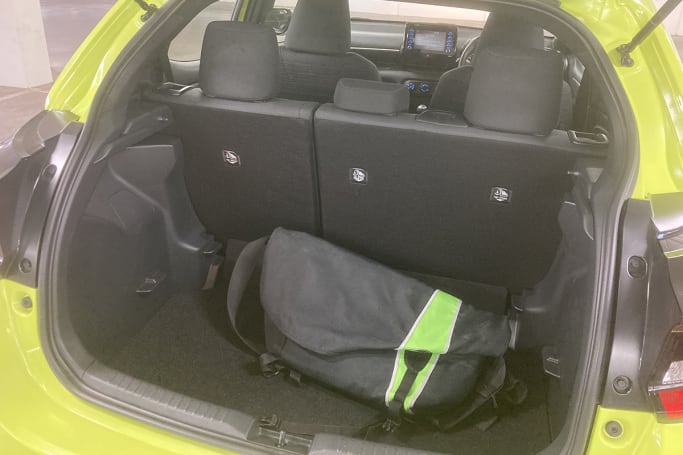
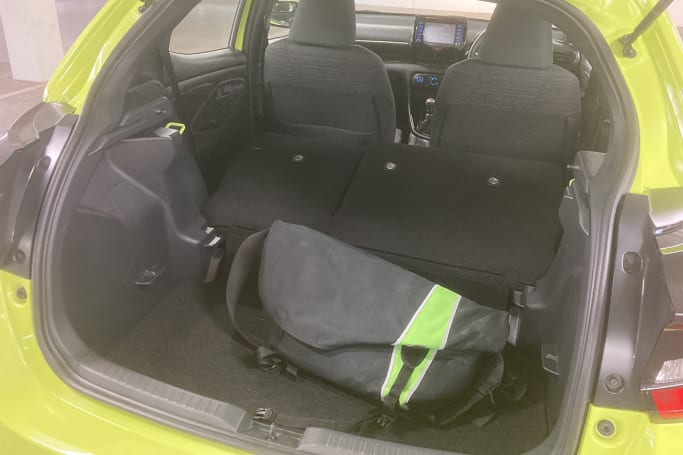
Toyota Yaris 2021 Seats
The Yaris' front seats feature a tall and narrow backrest with a tombstone design and a set number of reclining positions as opposed to the ratchet-style infinite mechanism preferred by European manufacturers. The narrowness allows rear-seat occupants to see forward without bulk or too much obstruction. And while the cushions look broad and flat, they're actually well padded for longer-journey comfort.
The second row has space for three passengers, but being a 1.7-metre wide supermini, it'll be a big squeeze back there. Best to treat it as a two-seater, even for taller adults, as there's support and comfort to be enjoyed. The trim is inviting and soft, and the overall experience positive. Note the backrest folds 60/40 but doesn't sit flush with the rear cargo floor.
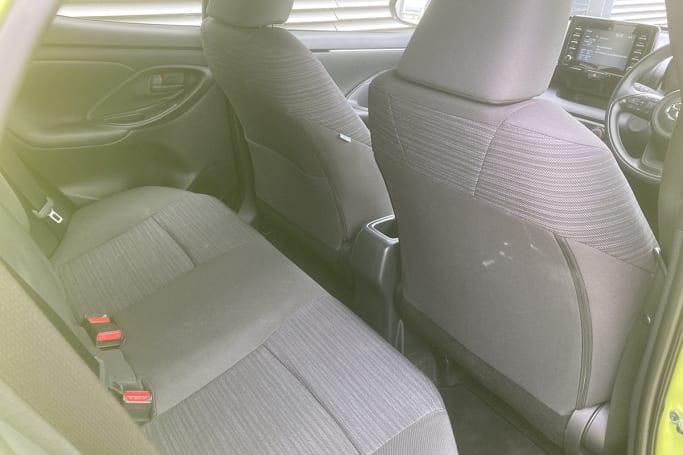
Toyota Yaris 2021 Speed
The Yaris with the 1.5-litre three-cylinder petrol engine has been tested to reach 100km/h from standstill in 9.7 seconds, on the way to a 175km/h top speed.


